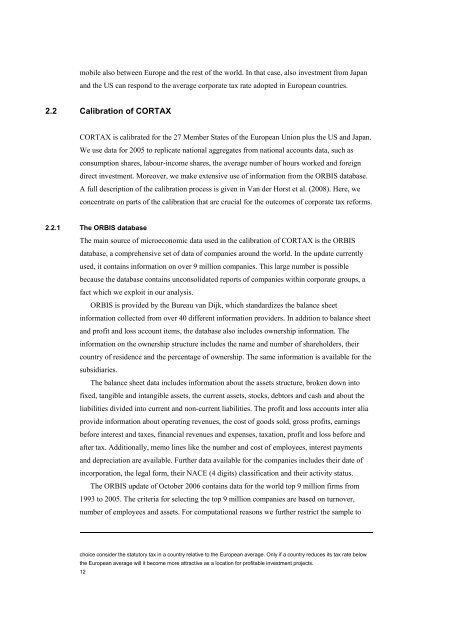The economic effects of EU-reforms in corporate income tax systems
The economic effects of EU-reforms in corporate income tax systems
The economic effects of EU-reforms in corporate income tax systems
You also want an ePaper? Increase the reach of your titles
YUMPU automatically turns print PDFs into web optimized ePapers that Google loves.
mobile also between Europe and the rest <strong>of</strong> the world. In that case, also <strong>in</strong>vestment from Japan<br />
and the US can respond to the average <strong>corporate</strong> <strong>tax</strong> rate adopted <strong>in</strong> European countries.<br />
2.2 Calibration <strong>of</strong> CORTAX<br />
CORTAX is calibrated for the 27 Member States <strong>of</strong> the European Union plus the US and Japan.<br />
We use data for 2005 to replicate national aggregates from national accounts data, such as<br />
consumption shares, labour-<strong>in</strong>come shares, the average number <strong>of</strong> hours worked and foreign<br />
direct <strong>in</strong>vestment. Moreover, we make extensive use <strong>of</strong> <strong>in</strong>formation from the ORBIS database.<br />
A full description <strong>of</strong> the calibration process is given <strong>in</strong> Van der Horst et al. (2008). Here, we<br />
concentrate on parts <strong>of</strong> the calibration that are crucial for the outcomes <strong>of</strong> <strong>corporate</strong> <strong>tax</strong> <strong>reforms</strong>.<br />
2.2.1 <strong>The</strong> ORBIS database<br />
<strong>The</strong> ma<strong>in</strong> source <strong>of</strong> micro<strong>economic</strong> data used <strong>in</strong> the calibration <strong>of</strong> CORTAX is the ORBIS<br />
database, a comprehensive set <strong>of</strong> data <strong>of</strong> companies around the world. In the update currently<br />
used, it conta<strong>in</strong>s <strong>in</strong>formation on over 9 million companies. This large number is possible<br />
because the database conta<strong>in</strong>s unconsolidated reports <strong>of</strong> companies with<strong>in</strong> <strong>corporate</strong> groups, a<br />
fact which we exploit <strong>in</strong> our analysis.<br />
ORBIS is provided by the Bureau van Dijk, which standardizes the balance sheet<br />
<strong>in</strong>formation collected from over 40 different <strong>in</strong>formation providers. In addition to balance sheet<br />
and pr<strong>of</strong>it and loss account items, the database also <strong>in</strong>cludes ownership <strong>in</strong>formation. <strong>The</strong><br />
<strong>in</strong>formation on the ownership structure <strong>in</strong>cludes the name and number <strong>of</strong> shareholders, their<br />
country <strong>of</strong> residence and the percentage <strong>of</strong> ownership. <strong>The</strong> same <strong>in</strong>formation is available for the<br />
subsidiaries.<br />
<strong>The</strong> balance sheet data <strong>in</strong>cludes <strong>in</strong>formation about the assets structure, broken down <strong>in</strong>to<br />
fixed, tangible and <strong>in</strong>tangible assets, the current assets, stocks, debtors and cash and about the<br />
liabilities divided <strong>in</strong>to current and non-current liabilities. <strong>The</strong> pr<strong>of</strong>it and loss accounts <strong>in</strong>ter alia<br />
provide <strong>in</strong>formation about operat<strong>in</strong>g revenues, the cost <strong>of</strong> goods sold, gross pr<strong>of</strong>its, earn<strong>in</strong>gs<br />
before <strong>in</strong>terest and <strong>tax</strong>es, f<strong>in</strong>ancial revenues and expenses, <strong>tax</strong>ation, pr<strong>of</strong>it and loss before and<br />
after <strong>tax</strong>. Additionally, memo l<strong>in</strong>es like the number and cost <strong>of</strong> employees, <strong>in</strong>terest payments<br />
and depreciation are available. Further data available for the companies <strong>in</strong>cludes their date <strong>of</strong><br />
<strong>in</strong>corporation, the legal form, their NACE (4 digits) classification and their activity status.<br />
<strong>The</strong> ORBIS update <strong>of</strong> October 2006 conta<strong>in</strong>s data for the world top 9 million firms from<br />
1993 to 2005. <strong>The</strong> criteria for select<strong>in</strong>g the top 9 million companies are based on turnover,<br />
number <strong>of</strong> employees and assets. For computational reasons we further restrict the sample to<br />
choice consider the statutory <strong>tax</strong> <strong>in</strong> a country relative to the European average. Only if a country reduces its <strong>tax</strong> rate below<br />
the European average will it become more attractive as a location for pr<strong>of</strong>itable <strong>in</strong>vestment projects.<br />
12
















